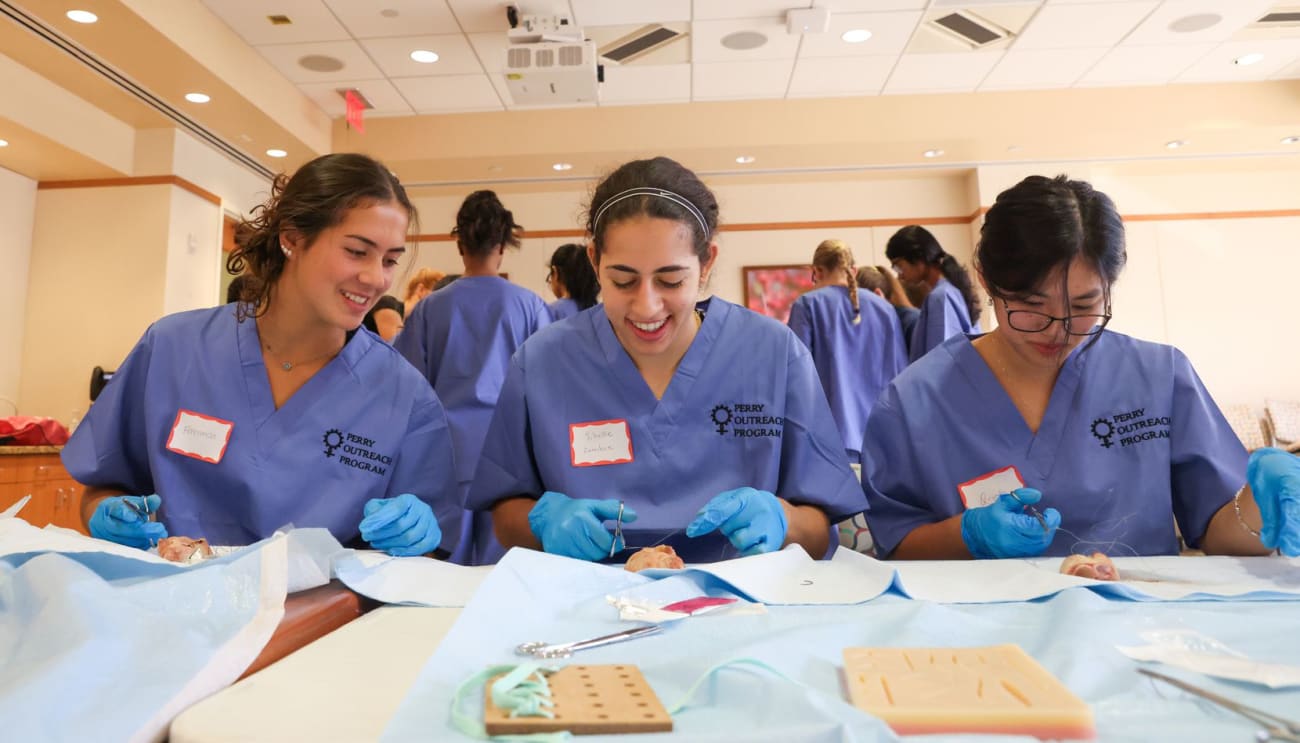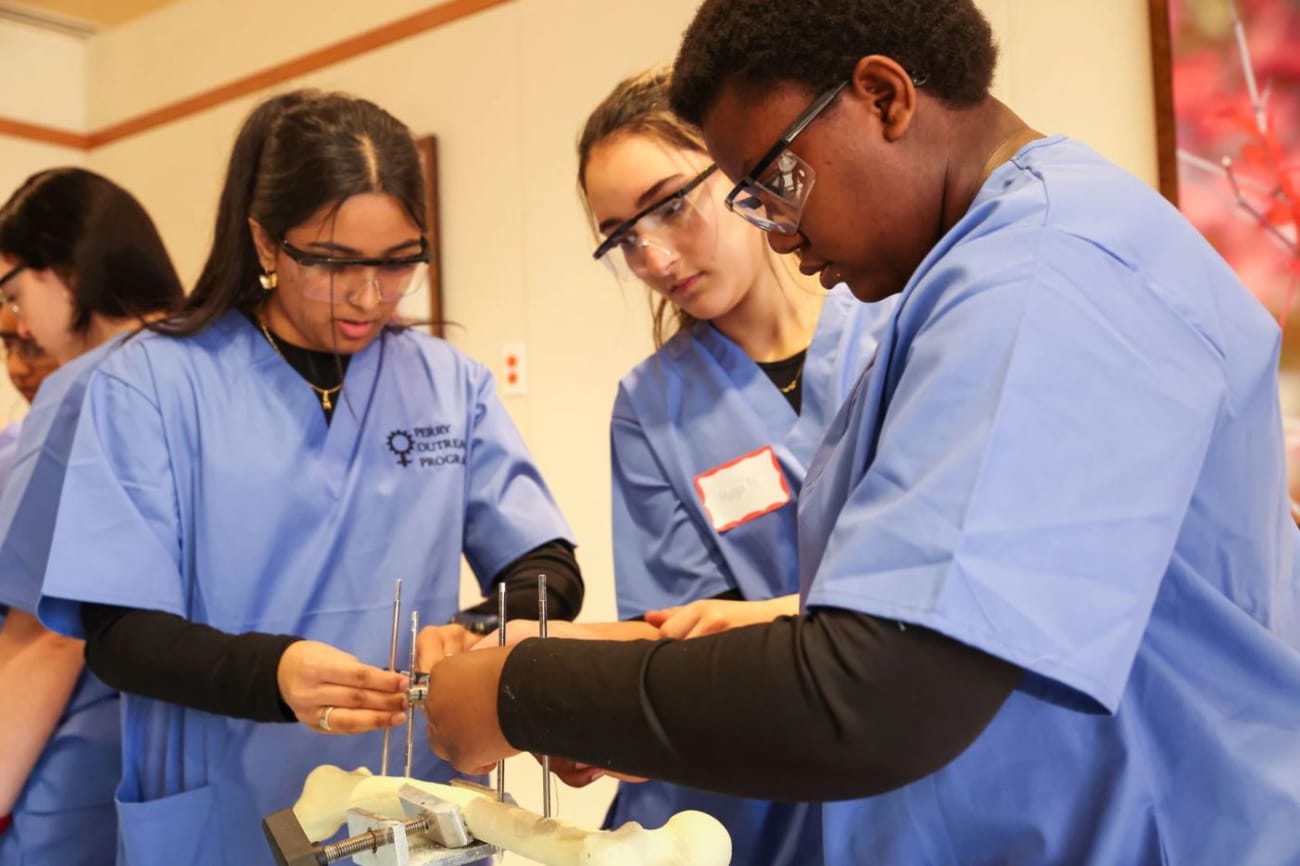A human bone is hard to break.
That’s why, when Julia Nicolescu, Worcester Polytechnic Institute biomedical engineering Ph.D. candidate, instructed one of the high school girls in blue scrubs to snap an artificial femur over her leg, the bone didn’t budge.
That’s also why orthopedic surgeons rely on heavy-duty saws and drills that look better suited for a garage toolbox than an operating room.
Each of the 40 North Texas high schoolers participating in the Perry Outreach Program at Texas Scottish Rite for Children took turns operating the red and black power tools on Saturday. Nicolescu, a fellow with the program, guided them through the feeling of a metal drill bit moving through layers of bone.
For many of the high school girls, it was their first experience in the world of orthopedics, one of the most male-dominated medical specialties. And hopefully, Dr. Amy McIntosh said, the mock surgeries will be just the beginning for these potential future doctors and engineers.
“It’s an eye-opening experience to say the sky’s the limit,” said McIntosh, a pediatric orthopedic surgeon and medical director of clinical safety at Scottish Rite. She, in partnership with The Perry Initiative, has organized the outreach program with Scottish Rite and UT Southwestern Medical Center for more than five years.
“It’s our goal to increase awareness that these fields are not just for guys. Girls can do it, too,” McIntosh said. “You can use power tools, you can do procedural skills. Even if you never used power tools as a kid, it’s a skill that everybody can learn.”

North Texas high schooler Fernanda Santos (left) looks over at Sibelle Zambie’s work as they practice sutures alongside Quynh Tran (right) during a learning event focused on orthopedic surgery and engineering hosted by The Perry Initiative at Scottish Rite for Children in Dallas on Saturday.(Liesbeth Powers / Staff Photographer)
The world of medicine has become increasingly diverse in recent decades, but some specialties remain largely segregated by sex. Surgical specialties, in particular, tend to be more male dominated. Women represented less than 6% of active orthopedic surgeons and less than 10% of active neurosurgeons in 2019, according to Association of American Medical Colleges data.
The high schoolers in this year’s cohort sawed through artificial bone, practiced suters on pigs’ feet and learned how to use ultrasound machines to view different joints. They also listened to lectures from medical and engineering specialists who get to do this work every day.
Ursuline Academy sophomore Logan Foster, 15, said she walked into the program scared she wasn’t prepared enough to even practice medical procedures. By lunch, she realized she had nothing to worry about.
“I thought I’d be a little bit out of my depth because I really don’t know anything about drilling or using power tools,” she said. “But, I know that I love to work with my hands and figure out puzzles. I’m definitely going to do something in engineering, something that uses machinery, because that was really fun.”
Alone in a sea of men
When McIntosh graduated from high school in the tiny town of Gladstone, Mich., becoming a doctor had never crossed her mind.
She enrolled at Central Michigan University and was selected for the school’s competitive sports medicine program to become an athletic trainer. McIntosh worked with student athletes as part of her studies and, once a week, she escorted the players to appointments with an orthopedic surgeon.
“In my junior year, I was like, ‘Maybe I just want to be the orthopedic surgeon,’” she said.
For the next 10 years, McIntosh completed every step necessary to become just that. She completed four years of medical school at Michigan State University, five years of an orthopedic surgery residency at the Mayo School of Graduate Medical Education, and a one-year fellowship in pediatric orthopedics and scoliosis at Scottish Rite.
With every step, she was surrounded by fewer and fewer women.
“You start to question yourself a little bit, but then I realized that I’m as smart as the boys, I can work as hard as the boys,” McIntosh said.

Amy Lynn McIntosh, M.D., at Scottish Rite for Children in Dallas during a learning event for North Texas high schoolers by The Perry Initiative on Saturday.(Liesbeth Powers / Staff Photographer)
McIntosh learned about The Perry Initiative about a decade ago. She felt immediately connected to the organization’s mission to give girls and young women exposure to orthopedic surgery and engineering.
Program specialists from The Perry Initiative, all women pursuing graduate degrees in science or engineering, travel the country nearly every weekend during the school year to host educational programs like the one held at Scottish Rite. On Oct. 22, the team will host another Perry Outreach Program in El Paso.
“I’m so passionate about The Perry Initiative because this is an opportunity that I would have absolutely been all over when I was in high school. It’s such an awesome exposure at a really critical time in your life when you’re figuring out what you want to do,” said Perry Initiative fellow Mary Kate Evans, a bioengineering Ph.D. candidate at the University of Pennsylvania.
The Perry Initiative provides the power tools and some other equipment, while Scottish Rite and UT Southwestern provide the space and additional experts to guide the six-and-a-half-hour-long day.
McIntosh expanded the program even further by bringing in ultrasound equipment and pediatric rheumatologists to introduce the girls to yet another medical specialty. Rheumatologists specialize in treating different inflammatory, musculoskeletal and autoimmune diseases.
The program continues long after the one-day session. Each participant gets McIntosh’s contact information and the promise that they can shadow her for one day in the operating room and one day in her clinic.
“The greatest part about this program is, now that I’m getting older, I see these women who have gone from high schoolers to undergrad to now they’re in medical school,” McIntosh said. “Whether or not they become an orthopedic surgeon, to me, is really meaningless. It’s the fact that we’re mentoring them along the way and they’ve seen that there’s possibilities.”
A glimpse into the future
The North Texas high schoolers participating in this year’s course are, in many ways, quite similar. Each had to apply to and be accepted into the program, and most of the girls are considering a career in medicine.
But the motivating factors behind coming to the Perry Outreach Program were deeply personal.
Pujitha Allu, a 16-year-old junior at Plano West Senior High School, said her friends recommended the program as a way to get hours of hands-on medical experience. Suturing, she said, was more difficult than she imagined, but that only excited her more to eventually master the skill.
Krisha Prabakaran, a 17-year-old senior at Centennial High School, learned about the opportunity after being a patient at Scottish Rite. Her spinal fusion surgery two years ago to treat her scoliosis sparked her desire to become an orthopedic surgeon.
“It’s really interesting because some of these mentors here are my doctors,” Prabakaran said. “It’s just crazy how, even though it’s not the same drills they use that carpenters use, but it’s the same concepts. You can literally build a house with this but also fix people with it.”

North Texas high schoolers Aanjali Patel (left), Maya Monfared, and Anatopenda Daphrose (right) tighten screws on a rod placed in a practice bone as part of a learning event about orthopedic surgery and engineering hosted by The Perry Initiative at Scottish Rite for Children in Dallas on Saturday.(Liesbeth Powers / Staff Photographer)
The wonder-filled – and sometimes queasy – looks on the faces of the high schoolers as they maneuvered the same tools that McIntosh uses in the operating room reaffirmed to the doctor that this program can and will change the future of orthopedic surgery.
“All of these predominantly male, white subspecialties, like ortho, neurosurgery, they realize that their future as a medical subspecialty truly is dependent on us recruiting talent. And if you’re only looking at a pool of talent that’s white males, you’re going to almost make yourself extinct,” McIntosh said.
“We want to get people to understand that the color of your skin or your gender has nothing to do with your ability to be a good surgeon or doctor,” she said. “Programs like this where we’re trying to recruit at the high school age is what we’re doing to improve the future.”





